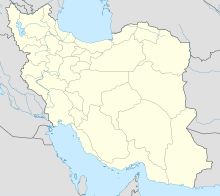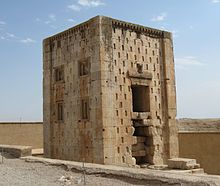Kaʿbe-ye tender
Coordinates: 29 ° 59 ′ 20 ″ N , 52 ° 52 ′ 29 ″ E
Kaʿbe-ye Zartuscht ( Persian کعبهٔ زرتشت, DMG Kaʿba von Zartuscht , 'Cube of Zarathustra') is a nearly twelve meter high tower, the Kaʿbe-ye Zartuscht , "Kaʿba (cube) Zarathustra " is called. It is located in the Naqsch-e Rostam archaeological site in the Iranian province of Fars . Presumably it was created under Darius I and is modeled on the similar, but badly damaged Zendan-e Soleyman (" Solomon's Prison ") in Pasargadae . The purpose of this construction is not known, but there are speculations that it was a fire temple or another royal burial place, although the former version is in doubt due to a missing fireplace. It may have been used as a repository for the writings of the Avesta during the Sassanid period . Sassanid inscriptions on the outer walls tell of the power struggle between the Sassanids and the Romans. According to Joseph von Hammer-Purgstall , the third or, according to other sources, the second of five or seven known fire temples of antiquity was located here:
- Among the geographical wonders of the world belong besides the already mentioned [...] sources the idol temples of Sumnat in India, Snbehar bey Ghasna, the fire temple Newbehar bey Balch, which have already been mentioned above, and then other fire temples, after the fires that are worshiped therein were known as: Asernush (the second of the seven fire temples of Persia, I 5c>), the first from Aserabad (at Tebris) has already occurred above. Aser Khordad (the third of the seven fire temples, and after some the second or fifth, at Shiraz, 1:29); Aser Barsin, that is, the fire of Perseus, the sixth in Khorasan; Aser Chorin, the fifth, also called Aserajin (1.85), like Aser Bersin, also called Rani Bersin (St. 27). Aser Behram, that is, the fire of Mars, the third, and Aser Seraduscht or Aser Serduscht, that is, the fire of Soroaster, the seventh of the fire temples of Persia.
literature
- Philip Huyse: The trilingual inscription of Šabuhr I on the Ka'ba-i Zardušt (ŠKZ) . 2 volumes, London 1999.
- Heidemarie Koch : Persepolis . Mainz 2001.
- Josef Wiesehöfer : The "dark centuries" of Persis . Munich 1994.
- Josef Wiesehöfer: Ancient Persia . Zurich 1994, new edition Düsseldorf 2005.
- Rüdiger Schmitt: The old Persian inscriptions of Naqsh-i Rustam and Persepolis. London 2000.
- Alexander Nagel: Everlasting Blues: Color and Epigraphic Habit in Achaemenid Persia, c. 520–330 BCE (2009; PDF; 17 kB)
- Joseph von Hammer-Purgstall : Advertisement of the Siebenmeer: together with an index with words Germanischer [...], Vienna 1831
- Carl Ritter: The geography of Asia. Vol. VIII, Berlin 1854
Web links
- Articles and picture gallery about Naqsch-e Rostam on Nirupars.com
- Ernst Herzfeld Persepolis Archive in the Freer Gallery of Art, Washington DC
- Kaʿbe-ye Delicately in the Encyclopædia Iranica
Notes and individual references
- ↑ Carl Ritter : The geography of Asia. Vol. VIII, Berlin 1854, p. 935.
- ↑ Somnath
- ↑ Spring or spring flower
- ↑ Naubahar ( New Spring or Nouruz )
- ↑ Azer Nusch ( lovely fire ) or Nush Azar, fire temple near Balkh, Baktra
- ↑ Azar Khordad ( fire of the twin , fire of well-being or Khor means sun , given dad, fire given by the sun )
- ↑ meant: Azar Aien means traditional fire
- ↑ Traditional fire
- ↑ Agni means fire
- ↑ Azar Zaradusht ( Fire of Zoroaster )
- ↑ Joseph von Hammer-Purgstall: Belong to the geographical wonders of the world. Gerold, Vienna 1831, p. 76f.


